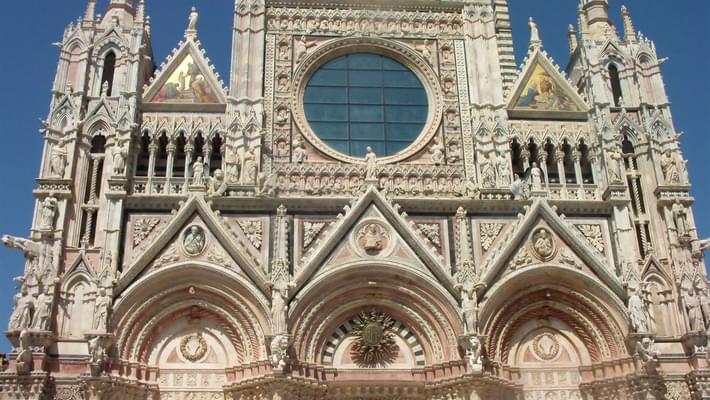About Musical Chapels of Siena Cathedral
Discover The Musical Chapels of Siena Cathedral
Established in 2001, The “Agostino Agazzari” Choir of Siena is the Cathedral’s official choir. Polyphony is a speciality of the choir, which is led by Cesare Mancini and boasts an extensive range of music, from Gregorian chants to experiences from the 20th century and studies of ancient musicians of Siena. Felicitated as the National Interest Group by the Italian Ministry of Cultural Heritage and Activities, the choir performs enthralling tours in places like England, Poland, Germany and Austria. They have also been a part of and are regularly invited to major festivals like the National Polyphony Festival of Camogli, the International Festival of Sainte-Baume, and the National Day of the Renaissance Organ. While the Agostino Agazzari organises the “Musica Senensis” festival to celebrate Sienese music, musicians, instruments, and places, they have always known universal appreciation of critics and the audience at all their performances. Cesare Mancini, apart from his role in the choir, is also known for his musical performances of works like Mozart’s Requiem.
Among the most crucial and revolutionary interventions in Sienese musical production and diffusion is the establishment of the “Guido Chigi Saracini” Choir of the Siena Cathedral. Established in September 2016 as a result of an alliance between the Accademia Musicale Chigiana and the Opera della Metropolitana, this musical chapel of Siena Cathedral is a vivid testimony of a fruitful relationship between artistic institutions that wish to make Siena an example for the rest of the musical world. Directed by the internationally renowned Maestro Lorenzo Donati, the choir has a classic experienced ensemble of 8 sopranos, 8 altos, 7 tenors, and 7 basses. The “Guido Chigi Saracini” project aims to diversify and enrich the musical community’s cultural heritage, for which it intends to create a stable artistic complex. Envisioned as a project that would combine sacred inspiration with quality concerts, the artistic complex is to be above the massive executive and interpretative practices of choirs.
Plan Your Visit
The opening hours of the Musical chapels of Siena Cathedral vary throughout the year, and it is recommended that you check the timings before planning your visit.
Monday to Saturday: 10:30 AM to 7:00 PM
Sunday: 9:30 AM to 6 PM
Admission is allowed until half an hour before closing time.
Plane – Musical chapels of Siena Cathedral can be reached using train or bus services from Pisa Airport, Rome Airport, Bologna Airport, and Perugia Airport. The nearest airport is the Florence Airport, which is at a distance of 55 kilometres from the Cathedral.
Train – The Siena Railway Station is located approximately two kilometres away from the Musical chapels of Siena Cathedral. One can reach the Cathedral from the station via bus or taxi in five minutes.
Car – As the Musical chapels of Siena Cathedral are located in the city’s historic centre, visitors are not permitted to drive directly to the attraction. It is recommended that you exit at Siena Ovest or at Siena Sud to reach the nearby parking facilities and walk down from there.
On Foot – It takes fifteen minutes to reach the Musical chapels of Siena Cathedral on foot from the Siena Railway Station. You can either choose to use the Stazione-Antiporto ski lift that provides a direct connection from the station to the Cathedral or walk down the streets.
FAQs
How many Musical Chapels are there in Siena Cathedral?
There are two Musical chapels of Siena Cathedral in modern times, the Coro “Agostino Agazzari” and the Coro della Cattedrale di Siena “Guido Chigi Saracini”. While the Agostino Agazzari is the official choir of the Cathedral, the Guido Chigi Saracini aims to transform the scene for musical chapels and make Siena an example for the musical world.
How old are the Musical chapels of Siena Cathedral?
Musical performances in the Siena Cathedral can be traced back to the 1215 Ordo Officiorum, although it took almost two centuries for the birth of a musical chapel in the mid-fifteenth century. With the arrival of Polish and Flemish singers who dominated the music scene of Europe, the musical chapels of Siena Cathedral became a constant feature by the turn of the sixteenth century.
How old is the Duomo in Siena?
Constructed between the years 1215 and 1263 in honour of the Virgin Mary by Pope Alexander IV, the Gothic Duomo in Siena is more than 800 years old.
What is the Siena Cathedral made of?
The Italian Romanesque-Gothic Siena Cathedral was constructed of white and greenish-black marble in alternating stripes on the interiors and exteriors, while red marble was used in the construction of its façade. The colours of the marble used to reflect the symbolic colours of Siena, black and white. The Cathedral also has stained glass windows, intrinsic mosaics and frescoes, and countless artworks adorning its floor and walls.
Is Siena Cathedral wheelchair accessible?
The Siena Cathedral is accessible for wheelchairs and has ramps available for the purpose. The Cathedral, however, might have spaces that are not wheelchair-accessible as the structure is massive and dates back to the Middle Ages.
Is Siena Cathedral worth visiting?
Known for its architectural grandeur, Siena Cathedral is an exemplary Gothic marvel that houses artworks by leading Renaissance artists like Michelangelo, Donatello, Pisano and Pinturicchio. The interiors of the Cathedral have inlaid marble panels designed by 40 leading mediaeval artists, along with treasures like the rose window by Duccio di Buoninsegna, St John the Baptist by Donatello, the Piccolomini Library, and the marble pulpit by Pisano. One of the most popular attractions of Tuscany, Siena Cathedral is a must-visit during your tour of the region.

